Going aloft can be either a heart-wrenching experience or an adrenaline rush to a room with a view. It certainly gives one a different perspective on things (published December 2015)
Getting to the masthead and back to deck level can be as safe and as pleasant as a walk in the park. Getting to and from the park, of course, has its own inherent risks, too. Preparation and practice will go a long way towards safely revealing an exciting view from aloft.
Whether fear is part of the formula or not largely depends on knowing the safe procedures for ascent and practicing them. During my 15 years as a bowman, “going up the rig” was part of the job description in virtually every ocean, all conditions and around the clock. Now, my occasional flight up the rig is merely a matter of getting a job done and an opportunity to re-visit my youth. Incorporating some of the newer techniques, here’s how to enjoy the experience.
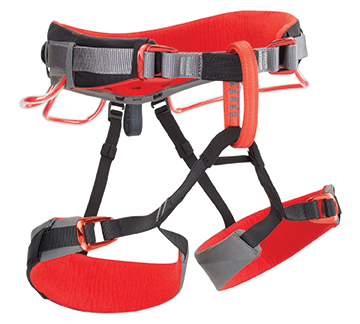
First, choose a high quality climbing harness. I’ve used Black Diamond as well as Petzl climbing harnesses available from REI, Easter Mountain Sports and other mountaineering stores, and I’ve also more recently used Spinlock’s mast harnesses. Although I frequently carry my own, older climbing harness, I found that the Petzl harness was significantly more comfortable than the older Black Diamond, and the Spinlock version of the climbing harness may be the most comfortable of all of them.
Climbing harnesses have an advantage over traditional, hard bottom bosun’s chairs. While up the rig, if you are tossed upside down, you will stay in a properly fitted climbing harness. In a bosun’s chair you could easily slip out and fall. Some people argue that a bosun’s chair is more comfortable, and in many cases that may be true. But if you get a well-designed climbing harness, you can have some degree of comfort and a vastly greater safety margin. For singlehanders going aloft, ATN makes mast ascending devices that allow a sailor to go up the rig without help from below and work at the very top of the mast. (See: http://www.atninc.com/atn-mastclimber-sailing-equipment.shtml)
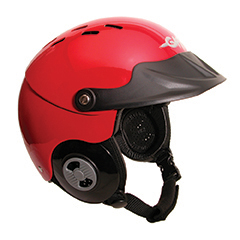
Further adding to the safety margin, several years ago I started wearing an offshore helmet when going aloft offshore. Sailing helmets can also be used to protect the helmsman from an onslaught of flying fish, but primarily I’ve used my Gath helmet while ascending the mast. (See: http://www.murrays.com/G-SH.html) I know for a fact that it has saved both my head and other sailors’ heads from banging into the rig when we went aloft. That alone was worth employing a helmet. If you think wearing a helmet while riding a bike and your head is 6 feet above the pavement is a good idea, you might consider wearing a helmet when your head is 80 or 100 feet above the deck and the mast is gyrating inches from your brain. It’s not a piece of gear merely designed for America’s Cup multihull sailors.
Attaching the halyard to the climbing harness is a critical safety step. I never rely on a halyard shackle to be the only or primary means of keeping me attached to the halyard. My preference is to have a screw post carabiner on the climbing harness. I then tie the halyard to the carabiner. A screw post carabiner is yet another piece of equipment from mountain climbing. The lightweight devices are locking so that they won’t open unless you make the effort to open them, and their breaking strength is certainly many times stronger than required.
Using a bowline knot to tie the halyard to the carabiner, the halyard shackle is free but still attached to me. If I clip a lazy halyard to the base of the mast and wind that halyard up hard, I can attach the halyard shackle that’s tied to me around the lazy halyard. As I go aloft, the lazy halyard acts as a guideline. If I lose my grip on the mast as the boat heels over, I will still remain relatively close to the mast. My arms and legs don’t need to work nearly so hard to stay close to the mast. Rather, they can be used to fend off from the mast as I take the express ride to the top.
Given an option, I generally think it is best to make normal mast inspections during daylight hours. However, if an emergency is at hand, working aloft may be necessary day or night. As a cruiser, you have to weigh the alternatives. If there is a significant possibility that delaying a trip up the mast until daylight may create or add to a serious problem, then I would think that a trip up the mast at night is warranted. Needless heroics shouldn’t be encouraged, but deferring a significant problem might lead to a greater problem than a night ascent. For night flights up the mast, I use a headlight rather than trying to hold a small flashlight between my teeth. There are several headlight models, originally designed for cave diving and mountain climbing. Petzl makes a very good model and there are also various LED models with long-lasting “bulbs”. Having the light strapped to your head leaves your mouth available for other things such as communicating with the rest of the crew.
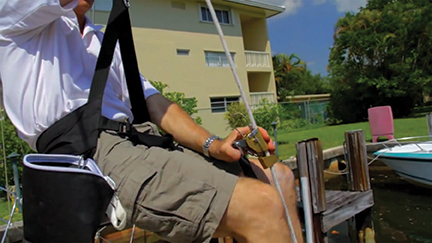
Good communications with the people on deck will go a long way toward making the trip aloft a safe one. A few other tips include: assign one person to watch and listen to the person going aloft especially as the sailor goes past spreaders, the inner forestay, baby stay, etc. Do not rely on the winch’s self tailers, and wearing shoes or boots while going aloft is definitely on the highly recommended list.
On deck, the tailer’s responsibility for safety cannot be overstated. It is his duty to ensure that there are enough wraps on the winch drum (at least three or four) while the person is going aloft. He takes in the halyard tail hand-over-hand, maintaining control at all times whether the winch has a self tailer or not. While the person is aloft doing his job, the tailer ensures that the line is securely tied off, again, not relying on self tailers as the only means of securing the line. As the person is descending, the tailer may reduce the number of wraps to two or three. While he is smoothly and steadily easing the halyard, one hand is placed loosely covering the line on the drum and prepared to stop the descent if necessary while the other hand allows the line to be eased. Either hand can stop the line with or without the aide of the other hand, but both hands should be used. Prior to lowering the person who is aloft, the halyard tail should have been flaked or laid out in a figure eight to ensure that the descent would be smooth.
Meanwhile, the helmsman needs to be aware of what is happening aloft. In very heavy weather his attention may be on wave patterns, and at night, he may be all consumed in driving. So he should be kept informed about what is happening up the mast. Is the person going up? Is he tied off and secure? Is he at the masthead? Someone should keep the deck watch informed if they can’t see for themselves. The person up the rig is the most important person on the boat when he is aloft.
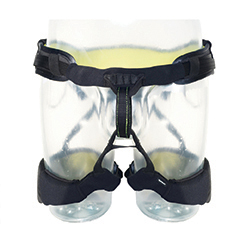
Prior to going aloft, the helmsman and person making the ascent should discuss which point of sail might be most appropriate. There’s no one right answer. In some cases, such as flat water with moderate breezes, close reaching or even beating may provide the most stable conditions aloft. In light air, broad reaching or running can result in the mast waving around at the masthead. In heavier conditions, rather than slamming over waves and pitching the masthead forward and aft, broad reaching may be more appropriate. If the person going aloft thinks it would be more stable for the helmsman to run off, the driver should attempt to maintain a wind angle of between 140 and 150 degrees—somewhere off the quarter. Running dead downwind should be avoided so that there is no danger of an accidental jibe. Similarly, if the person going aloft thinks it best to go to weather, a close reach may be best. Beating may cause too much slamming as the boat goes over the waves, especially on a multihull. Each hull hits the wave at a different time, adding to the jerky motion at deck level—a motion which is amplified up the rig.
Mast steps are a useful and convenient way to get up the mast, but with a great deal of heel or erratic motion, it becomes progressively more difficult to use them. Whether using mast steps or not, however, a good climbing harness, properly worn and attached is still very highly recommended. To think that you can get aloft without a safety backup is to court disaster. We have had steps on multihulls on which I’ve sailed, and they certainly made it easier to tail the halyard as the other person went aloft. Regardless of the steps, however, we always employed thorough safety systems when going up the mast, and we occasionally trailed a tagline behind us and attached to the back of the harness as we went up.
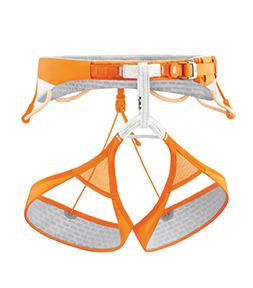
Taglines attached to the person going aloft have several purposes. Often. they are used to retrieve additional equipment from deck-level. If the person aloft needs a screw driver or another tube of silicon, it can be attached to the line, and the person aloft can haul it up more easily than coming back to deck level and fetching it. Sometimes they are used to bring a lazy halyard back to the deck while the other person remains aloft. Taglines can also be used to position a person “in space”.
Using several taglines—one run forward, one aft, and one athwartships, aboard fully crewed boats we have been able to haul someone aloft and position him in the middle of a hoisted mainsail for repairs or in other awkward places. But one of the main reasons is to be able to bring a person safely down from the rig by pulling him slightly away from the mast if he is unconscious. It can be a safety line back to the deck as the tagline pulls the person slightly forward and the halyard is eased.
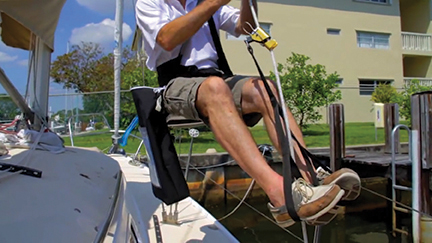
By learning the safest techniques with good people on board and using the techniques in fair weather as well as foul, the risk of injury is minimized. By making frequent trips up the rig when conditions are good, you become more accustomed to the heights and procedures. The frequent trips aloft in good conditions also serve another purpose; they minimize the likelihood that a flight up the mast in heavy weather will be required. Double check the equipment every time you go up. Good practice makes perfect. Like they say on the airplanes, “Buckle up, and enjoy the flight!”

















